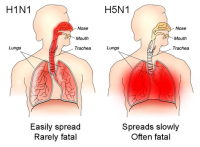-
Climate change to increase health risks from wildfires in U.S. West
A surge in major wildfire events in the western United States as a consequence of climate change will expose tens of millions of Americans to high levels of air pollution in the coming decades. The researchers estimated air pollution from past and projected future wildfires in 561 western counties, and found that by mid-century more than eighty-two million people will experience “smoke waves,” or consecutive days with high air pollution related to fires.
-
-
Six million Americans drink water with unsafe levels of toxic chemicals
Levels of a widely used class of industrial chemicals linked with cancer and other health problems exceed federally recommended safety levels in public drinking water supplies for six million people in the United States, according to a new study.
-
-
Brazil’s sewage woes reflect the growing global water quality crisis

All eyes are turned toward Rio de Janeiro to watch top athletes compete, yet the headlines continue to highlight the problems with the water quality and the risks to the athletes who swim, row, and sail, and even to tourists simply visiting the beaches. But Brazil’s wastewater woes are hardly unique. The water quality of lakes, rivers, and coastal shorelines around the world is degrading at an alarming rate. In fact, pollution of the ten largest rivers on earth is so significant that it affects five billion people. While the spotlight is shining on the athletes over the next few weeks, let us also shine a spotlight on what we can do to improve and restore water quality around the world through our collective efforts, use of new tools, and risk frameworks, moving the political will one step closer toward sewage treatment and protection of the biohealth of the blue planet.
-
-
Researchers projecting epidemic’s spread say Zika cases are under-reported

With the report from Florida governor Rick Scott on Monday that fourteen people in the state have been infected with the Zika virus most likely through mosquito transmission, the concern about outbreaks in the United States has intensified. A new study, along with interactive maps, provides current numbers as well projections for the number of Zika cases in the Americas through January 2017. It also provides projections for the number of microcephaly cases associated with the disease through October 2017, a date chosen to allow for the nine months of pregnancy.
-
-
In Zika, echoes of U.S. rubella outbreak of 1964-65

Just over fifty years ago, a highly contagious but seemingly harmless virus swept through the United States, infecting as many as 12.5 million people. In both adults and children, the virus presented as a mild illness, but caused birth defects in some babies born to women who were infected while pregnant. Does this sound familiar? Though separated by time and place, there are surprising similarities in the social issues raised by the rubella outbreak of 1964-65 and the recent Zika outbreak in South America. Both viruses can cause birth defects, a fact that ties them to social issues surrounding pregnancy, women’s health, and the politics of abortion.
-
-
Reducing U.S. firearm suicide rates

In 2014, of the more than 33,500 firearm deaths in the United States, over 21,000 were the result of suicide. Studies in the United States showed that greater firearm availability is associated with greater risk of firearm suicide. Globally, four studies in other developed countries found that per capita gun ownership correlates with national firearm suicide rates. To reduce firearm suicide rates in the United States, the authors recommended several measures, such as targeted legislation to limit firearm access to individuals at risk for suicide, using smart gun technology, offering public education on firearm suicide, and research to evaluate the effectiveness of prevention methods.
-
-
GMOs lead the fight against Zika, Ebola and the next unknown pandemic
The shadow of the Zika virus hangs over the Rio Olympic Games, with visitors and even high-profile athletes citing worries about Zika as a reason to stay away (even if the risk is probably quite low). The public’s concerns are a striking example of the need to rapidly combat emerging infectious diseases. In the fight against Zika, public health experts have turned to what may sound like an unlikely ally: genetically modified organisms, or GMOs. To protect the public, scientists have embraced GMO technology to quickly study new health threats, manufacture enough protective vaccines, and monitor and even predict new outbreaks. With the help of GMOs, infectious disease experts have the tools to get ahead of the next outbreak, moving beyond reaction to quick detection, containment and even prevention.
-
-
Gene-drive modified organisms not yet ready to be released into environment: Scientists
The emerging science of gene drives has the potential to address environmental and public health challenges, but gene-drive modified organisms are not ready to be released into the environment and require more research in laboratories and highly controlled field trials, says a new report from the National Academies of Sciences.
-
-
UN urges heightened vigilance after H5N1 outbreaks in West and Central Africa

The United Nations Food and Agricultural Organization (FAO) alerted Western and Central African governments to be vigilant, and to continue their raised surveillance and prevention efforts after H5N1 avian influenza outbreaks were recently confirmed in chicken farms in Cameroon. The UN notes that the recent outbreak in Cameroon has brought the number of countries that have battled bird flu in West and Central Africa to six, also including Burkina Faso, Cote d’Ivoire, Ghana, Niger, and Nigeria.
-
-
New control strategies needed for Zika, other unexpected mosquito-borne outbreaks
A recent spate of unexpected mosquito-borne disease outbreaks — most recently the Zika virus, which has swept through parts of the Americas — have highlighted the need to better understand the development and spread of little-known diseases and for new strategies to control them, researchers say. They say that despite the discovery of Zika in Uganda in 1947 and the identification of the first confirmed human infection in Nigeria six years later, few cases were reported in humans until 2007. Even then, no one understood the grave risk the disease posed to pregnancies until the recent outbreak in Brazil, which began less than two years ago.
-
-
Zika epidemic likely to burn itself out within three years

The current Zika epidemic in Latin America is likely to burn itself out within three years, suggests new research. The findings also conclude the epidemic cannot be contained with existing control measures. The researchers predict the next large-scale epidemic is unlikely to emerge for at least another ten years — although there is a possibility of smaller outbreaks in this time.
-
-
100s of deaths in two cities in 2003 heatwave due to man-made climate change: Scientists

Scientists have specified how many deaths can be attributed to man-made climate change during an extreme heatwave in two European cities in 2003. The study says that with climate change projected to increase the frequency and severity of future heatwaves, these results highlight an emerging trend. The authors suggest that such research gives policymakers better information about the damaging effects of heatwaves to help them respond to the future challenges of climate change.
-
-
Influenza outbreak would cost U.S. billions of dollars in losses
An influenza pandemic would cost the nation tens of billions of dollars in economic losses — nearly double what previous estimates showed, a new study reveals. The study, which was funded by the National Biosurveillance Integration Center of the U.S. Department of Homeland Security, found that the nation would lose as much as $45 billion in gross domestic product if Americans failed to get vaccinated for the flu, compared with $34 billion if they were vaccinated.
-
-
The politicization of U.S. handling Ebola may carry over to Zika
If the United States responds to Zika the way it did to Ebola — and early indications are that in many ways it is — the country can expect missteps brought about by a lack of health care coordination and a lot of political finger pointing, according to a new analysis. The researchers studied the U.S. response to Ebola and found a fragmented system with no clear leadership, and considerable “strategic politicization” due to the outbreak’s arrival during a midterm election year.
-
-
U.S. needs greater preparation for next severe public health threats: Experts panel

In a report released last week by the U.S. Department of Health and Human Services (HHS), an Independent Panel formed to review HHS’s response to Ebola made several recommendations on how the nation’s federal public health system should strengthen its response to major public health threats, both internationally and domestically. “Without focused and sustained effort, the result of other novel public health threats could be much more devastating,” said the chairman of the Independent Panel.
-
More headlines
The long view
What We’ve Learned from Survivors of the Atomic Bombs
Q&A with Dr. Preetha Rajaraman, New Vice Chair for the Radiation Effects Research Foundation in Hiroshima and Nagasaki, Japan.
Combatting the Measles Threat Means Examining the Reasons for Declining Vaccination Rates
Measles was supposedly eradicated in Canada more than a quarter century ago. But today, measles is surging. The cause of this resurgence is declining vaccination rates.
Vaccine Integrity Project Says New FDA Rules on COVID-19 Vaccines Show Lack of Consensus, Clarity
Sidestepping both the FDA’s own Vaccines and Related Biological Products Advisory Committee and the CDC’s Advisory Committee on Immunization Practices (ACIP), two Trump-appointed FDA leaders penned an opinion piece in the New England Journal of Medicine to announce new, more restrictive, COVID-19 vaccine recommendations. Critics say that not seeking broad input into the new policy, which would help FDA to understand its implications, feasibility, and the potential for unintended consequences, amounts to policy by proclamation.
